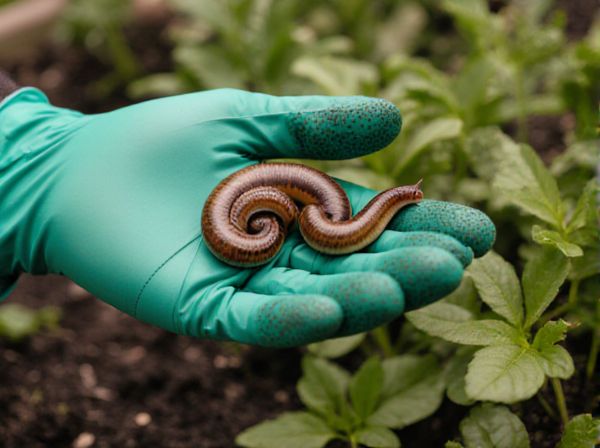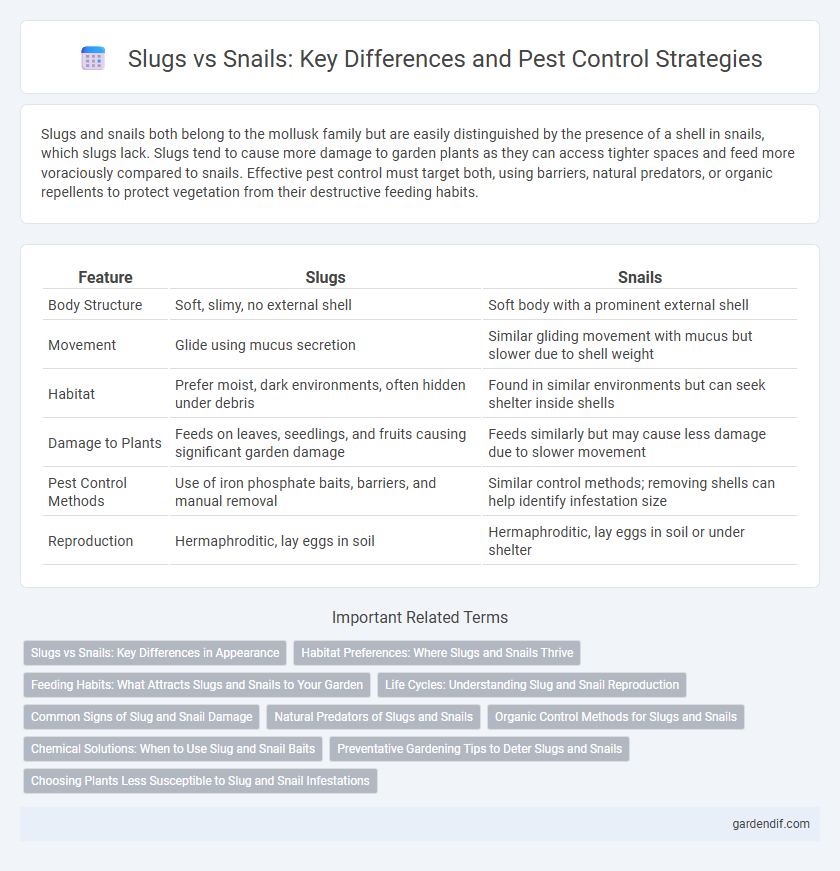
Slugs vs Snails Illustration
Slugs and snails both belong to the mollusk family but are easily distinguished by the presence of a shell in snails, which slugs lack. Slugs tend to cause more damage to garden plants as they can access tighter spaces and feed more voraciously compared to snails. Effective pest control must target both, using barriers, natural predators, or organic repellents to protect vegetation from their destructive feeding habits.
Table of Comparison
| Feature | Slugs | Snails |
|---|---|---|
| Body Structure | Soft, slimy, no external shell | Soft body with a prominent external shell |
| Movement | Glide using mucus secretion | Similar gliding movement with mucus but slower due to shell weight |
| Habitat | Prefer moist, dark environments, often hidden under debris | Found in similar environments but can seek shelter inside shells |
| Damage to Plants | Feeds on leaves, seedlings, and fruits causing significant garden damage | Feeds similarly but may cause less damage due to slower movement |
| Pest Control Methods | Use of iron phosphate baits, barriers, and manual removal | Similar control methods; removing shells can help identify infestation size |
| Reproduction | Hermaphroditic, lay eggs in soil | Hermaphroditic, lay eggs in soil or under shelter |
Slugs vs Snails: Key Differences in Appearance
Slugs lack the external shell that snails have, appearing as soft, elongated bodies with visible tentacles, while snails carry a coiled, hard shell on their back for protection. Slugs usually have a more slimy, moist texture enabling them to move through narrow spaces, whereas snails have a dryer body outside the shell, providing extra defense against predators. Size and color can vary, but the absence or presence of a shell remains the most distinct visual difference between slugs and snails.
Habitat Preferences: Where Slugs and Snails Thrive
Slugs prefer moist, shaded environments with abundant organic matter, such as leaf litter, garden mulch, and damp soil, which provide essential moisture and shelter. In contrast, snails thrive in similar moist habitats but often require calcium-rich soils or surfaces due to their hard shells, commonly found in gardens, forests, and areas with limestone or chalky substrates. Both pests are most active in cool, humid conditions, avoiding dry or exposed locations that increase the risk of desiccation.
Feeding Habits: What Attracts Slugs and Snails to Your Garden
Slugs and snails are primarily attracted to moist, shady environments rich in decaying plant material and tender vegetation, which serve as their main food sources. They prefer feeding on young leaves, fruits, and seedlings, causing significant damage to garden plants and crops. Organic mulches, overwatered soils, and dense ground cover increase the likelihood of slug and snail infestations by providing optimal conditions for their survival and feeding activity.
Life Cycles: Understanding Slug and Snail Reproduction
Slug and snail life cycles share similarities, with both undergoing egg, juvenile, and adult stages, but slugs typically experience a shorter development period ranging from 2 to 3 months, whereas snails often take 3 to 6 months to mature. Both pests are hermaphrodites, meaning each individual can produce eggs after mating, allowing rapid population growth under favorable conditions. Understanding the reproductive habits and life cycle durations of slugs and snails is crucial for effective pest management and control strategies.
Common Signs of Slug and Snail Damage
Slugs and snails leave distinctive damage on plants, characterized by irregular holes and slime trails on leaves and stems. Both pests typically target tender foliage and young seedlings, causing wilting and stunted growth due to their feeding habits. Close inspection often reveals silvery mucus trails, a key indicator differentiating their presence from other garden pests.
Natural Predators of Slugs and Snails
Ground beetles and certain species of frogs are effective natural predators of slugs and snails, feeding on their soft bodies and helping control their populations. Birds such as thrushes and ducks also contribute by consuming large numbers of these mollusks in gardens and agricultural fields. Nematodes like Phasmarhabditis hermaphrodita specifically target slugs, providing a biological control option that reduces reliance on chemical pesticides.
Organic Control Methods for Slugs and Snails
Organic control methods for slugs and snails include applying iron phosphate-based baits that are safe for pets and wildlife, creating physical barriers such as copper tape or crushed eggshells around plants, and encouraging natural predators like birds, frogs, and beetles. Handpicking these pests during the evening or early morning reduces their population without chemical use, while maintaining dry soil and removing excessive mulch can deter their habitat. Companion planting with herbs like rosemary, sage, and thyme also helps repel slugs and snails naturally.
Chemical Solutions: When to Use Slug and Snail Baits
Slug and snail baits containing active ingredients like metaldehyde or iron phosphate are effective chemical solutions when infestations threaten gardens or crops. Use these baits during damp conditions or after rainfall to maximize effectiveness, as both slugs and snails are most active in moist environments. Proper bait placement near feeding areas minimizes environmental impact while targeting these pests efficiently.
Preventative Gardening Tips to Deter Slugs and Snails
Applying diatomaceous earth around garden beds creates a barrier that deters slugs and snails by damaging their soft bodies. Planting slug-resistant vegetation such as lavender, rosemary, and mint helps reduce these pests naturally. Maintaining dry garden conditions by avoiding excessive watering minimizes slug and snail activity, protecting vulnerable plants effectively.
Choosing Plants Less Susceptible to Slug and Snail Infestations
Choosing plants less susceptible to slug and snail infestations improves garden resilience by reducing damage and maintenance efforts. Varieties like lavender, rosemary, and fennel possess natural repellents that deter these pests, while tough-leaved plants such as geraniums and fuchsias typically experience less feeding activity. Incorporating these species helps create a pest-resistant landscape that minimizes reliance on chemical controls and fosters healthier plant growth.
Slugs vs Snails Infographic

 gardendif.com
gardendif.com